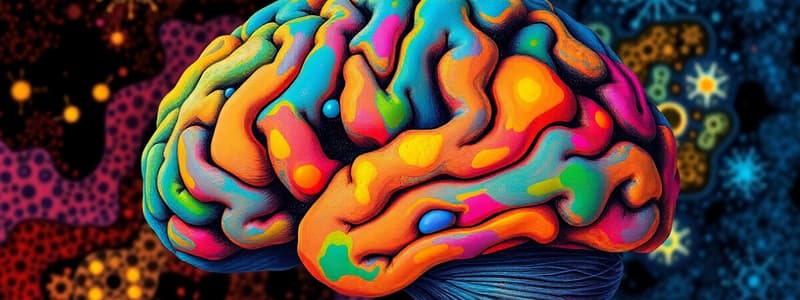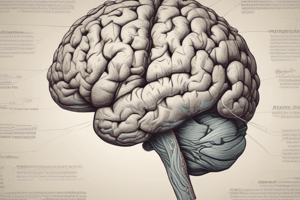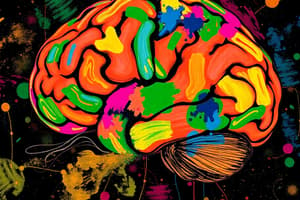Podcast
Questions and Answers
Which of the diencephalon's components primarily processes auditory information before relaying it to the cerebral cortex?
Which of the diencephalon's components primarily processes auditory information before relaying it to the cerebral cortex?
- Pineal Body
- Habenular Nuclei
- Lateral Geniculate Body
- Medial Geniculate Body (correct)
A lesion in which of the following diencephalic structures would most likely result in a disruption of circadian rhythms?
A lesion in which of the following diencephalic structures would most likely result in a disruption of circadian rhythms?
- Habenular Commissure
- Pineal Body (correct)
- Lateral Geniculate Body
- Dorsal Thalamus
If a patient presents with visual processing deficits after a brain injury, which specific structure within the diencephalon is most likely affected?
If a patient presents with visual processing deficits after a brain injury, which specific structure within the diencephalon is most likely affected?
- Lateral Geniculate Body (correct)
- Dorsal Thalamus
- Habenular Nuclei
- Medial Geniculate Body
Which diencephalic structure is most directly involved in relaying sensory information to the cerebral cortex, excluding olfactory sensation?
Which diencephalic structure is most directly involved in relaying sensory information to the cerebral cortex, excluding olfactory sensation?
Damage to which of the following structures of the diencephalon would most likely affect the regulation of endocrine functions?
Damage to which of the following structures of the diencephalon would most likely affect the regulation of endocrine functions?
Which structure contains both thalamocortical and corticothalamic fibers, and is located laterally, separating the reticular nucleus from the rest of the thalamic mass?
Which structure contains both thalamocortical and corticothalamic fibers, and is located laterally, separating the reticular nucleus from the rest of the thalamic mass?
If a lesion interrupts the stria medullaris thalami, which of the following functions would be MOST directly affected?
If a lesion interrupts the stria medullaris thalami, which of the following functions would be MOST directly affected?
The Y-shaped band that divides the thalamus into Anterior, Medial & Lateral nuclear groups is known as what?
The Y-shaped band that divides the thalamus into Anterior, Medial & Lateral nuclear groups is known as what?
Which of the following best describes the anatomical relationship between the thalamus and the internal capsule?
Which of the following best describes the anatomical relationship between the thalamus and the internal capsule?
Which surface of the thalamus rests on the subthalamus and hypothalamus structures?
Which surface of the thalamus rests on the subthalamus and hypothalamus structures?
Which thalamic nucleus is NOT primarily involved in relaying motor information?
Which thalamic nucleus is NOT primarily involved in relaying motor information?
The lateral geniculate body (LGB) processes visual information from which of the following sources?
The lateral geniculate body (LGB) processes visual information from which of the following sources?
A patient presents with sensory deficits primarily affecting the contralateral half of their body. Which thalamic nucleus is MOST likely involved?
A patient presents with sensory deficits primarily affecting the contralateral half of their body. Which thalamic nucleus is MOST likely involved?
Which of the following describes the functional role of the medial geniculate body (MGB)?
Which of the following describes the functional role of the medial geniculate body (MGB)?
Damage to the ventral anterior nucleus of the thalamus would MOST likely result in deficits related to:
Damage to the ventral anterior nucleus of the thalamus would MOST likely result in deficits related to:
Which thalamic nucleus receives input from the dentate nucleus?
Which thalamic nucleus receives input from the dentate nucleus?
Which of the following thalamic nuclei is considered part of the limbic system?
Which of the following thalamic nuclei is considered part of the limbic system?
The ventral posterior medial nucleus (VPM) processes sensory information from which region?
The ventral posterior medial nucleus (VPM) processes sensory information from which region?
Which of the following structures is located within the ventralis pars of the diencephalon?
Which of the following structures is located within the ventralis pars of the diencephalon?
A lesion affecting the lateral wall of the third ventricle would most likely directly impact which diencephalic structure?
A lesion affecting the lateral wall of the third ventricle would most likely directly impact which diencephalic structure?
The interthalamic adhesion (massa intermedia) directly connects which two structures?
The interthalamic adhesion (massa intermedia) directly connects which two structures?
If a horizontal section of the brain reveals the interthalamic adhesion, at what level of the thalamus is the section being observed?
If a horizontal section of the brain reveals the interthalamic adhesion, at what level of the thalamus is the section being observed?
Which structure is located immediately anterior to the anterior pole of the thalamus?
Which structure is located immediately anterior to the anterior pole of the thalamus?
Damage to the pulvinar might lead to deficits relating to the function of which structure?
Damage to the pulvinar might lead to deficits relating to the function of which structure?
What structure is found immediately dorsal to the thalamus?
What structure is found immediately dorsal to the thalamus?
Which structure is found immediately ventral to the thalamus?
Which structure is found immediately ventral to the thalamus?
Which of the following structures is situated between the caudate nucleus and the thalamus?
Which of the following structures is situated between the caudate nucleus and the thalamus?
A tumor affecting the terminal sulcus is most likely to directly impact the:
A tumor affecting the terminal sulcus is most likely to directly impact the:
Which thalamic nuclei group plays a crucial role in integrating emotion, thought, and judgement, while also interacting with the prefrontal cortex and limbic structures?
Which thalamic nuclei group plays a crucial role in integrating emotion, thought, and judgement, while also interacting with the prefrontal cortex and limbic structures?
Damage to the intralaminar nuclei would most likely result in which of the following?
Damage to the intralaminar nuclei would most likely result in which of the following?
The reticular nucleus of the thalamus is uniquely positioned to regulate thalamic activity because of its location and connections. Where is it located?
The reticular nucleus of the thalamus is uniquely positioned to regulate thalamic activity because of its location and connections. Where is it located?
Which of the following is NOT a primary function of the thalamus?
Which of the following is NOT a primary function of the thalamus?
A patient presents with impaired control of instinctive drives and altered emotional responses. Dysfunction in which of the following thalamic areas is MOST likely contributing to these symptoms?
A patient presents with impaired control of instinctive drives and altered emotional responses. Dysfunction in which of the following thalamic areas is MOST likely contributing to these symptoms?
A researcher is investigating the role of the thalamus in sensory perception. If they were to selectively disrupt the function of the pulvinar nucleus, which of the following sensory deficits would MOST likely occur?
A researcher is investigating the role of the thalamus in sensory perception. If they were to selectively disrupt the function of the pulvinar nucleus, which of the following sensory deficits would MOST likely occur?
A neurologist is examining a patient who has suffered a stroke affecting a specific thalamic pathway. The patient exhibits difficulty in forming new memories and experiences emotional disturbances. Which pathway is MOST likely affected?
A neurologist is examining a patient who has suffered a stroke affecting a specific thalamic pathway. The patient exhibits difficulty in forming new memories and experiences emotional disturbances. Which pathway is MOST likely affected?
Visceral functions can be affected by damage to which area?
Visceral functions can be affected by damage to which area?
Which of the following best describes the functional distinction between first-order (FO) and higher-order (HO) thalamic nuclei regarding cortical communication?
Which of the following best describes the functional distinction between first-order (FO) and higher-order (HO) thalamic nuclei regarding cortical communication?
If a researcher is studying the influence of cerebellar output on motor cortex activity, which thalamic nucleus would be most relevant to target for investigation?
If a researcher is studying the influence of cerebellar output on motor cortex activity, which thalamic nucleus would be most relevant to target for investigation?
A patient presents with impaired sensory discrimination of touch and proprioception from the body. Which thalamic nucleus is most likely affected by a lesion?
A patient presents with impaired sensory discrimination of touch and proprioception from the body. Which thalamic nucleus is most likely affected by a lesion?
Which of the following thalamic nuclei is considered a higher-order nucleus and plays a role in prefrontal cortex function?
Which of the following thalamic nuclei is considered a higher-order nucleus and plays a role in prefrontal cortex function?
What is the primary distinction between the Anterior Medial (AM) and Anterior Ventral (AV) thalamic nuclei in terms of their afferent connections?
What is the primary distinction between the Anterior Medial (AM) and Anterior Ventral (AV) thalamic nuclei in terms of their afferent connections?
Flashcards
Diencephalon
Diencephalon
The part of the brain located between the cerebrum and brainstem, includes the thalamus and hypothalamus.
Thalamus
Thalamus
A structure in the diencephalon that acts as a relay station for sensory and motor signals to the cerebral cortex.
Metathalamus
Metathalamus
Part of the thalamus, consisting of the medial and lateral geniculate bodies involved in auditory and visual processing.
Epithalamus
Epithalamus
Signup and view all the flashcards
Hypothalamic sulcus
Hypothalamic sulcus
Signup and view all the flashcards
Lateral Surface of Thalamus
Lateral Surface of Thalamus
Signup and view all the flashcards
Medial Surface of Thalamus
Medial Surface of Thalamus
Signup and view all the flashcards
External Medullary Lamina
External Medullary Lamina
Signup and view all the flashcards
Internal Medullary Lamina
Internal Medullary Lamina
Signup and view all the flashcards
Thalamic Nuclei
Thalamic Nuclei
Signup and view all the flashcards
Commissure
Commissure
Signup and view all the flashcards
Stria Medullaris Thalami
Stria Medullaris Thalami
Signup and view all the flashcards
Pulvinar
Pulvinar
Signup and view all the flashcards
Interthalamic adhesion
Interthalamic adhesion
Signup and view all the flashcards
Superior colliculus
Superior colliculus
Signup and view all the flashcards
Caudate nucleus
Caudate nucleus
Signup and view all the flashcards
Lateral ventricle
Lateral ventricle
Signup and view all the flashcards
Ventral Anterior Nucleus
Ventral Anterior Nucleus
Signup and view all the flashcards
Ventral Lateral Nucleus
Ventral Lateral Nucleus
Signup and view all the flashcards
Ventral Posterior Nucleus
Ventral Posterior Nucleus
Signup and view all the flashcards
Lateral Geniculate Body
Lateral Geniculate Body
Signup and view all the flashcards
Medial Geniculate Body
Medial Geniculate Body
Signup and view all the flashcards
Dorsomedial Nucleus
Dorsomedial Nucleus
Signup and view all the flashcards
First Order Thalamic Nuclei
First Order Thalamic Nuclei
Signup and view all the flashcards
High Order Thalamic Nuclei
High Order Thalamic Nuclei
Signup and view all the flashcards
Ventral Posterolateral Nucleus (VPL)
Ventral Posterolateral Nucleus (VPL)
Signup and view all the flashcards
Lateral Geniculate Nucleus (LGN)
Lateral Geniculate Nucleus (LGN)
Signup and view all the flashcards
Pulvinar Nucleus
Pulvinar Nucleus
Signup and view all the flashcards
Hippocampus
Hippocampus
Signup and view all the flashcards
Cingulate Gyrus
Cingulate Gyrus
Signup and view all the flashcards
Mediodorsal Nucleus
Mediodorsal Nucleus
Signup and view all the flashcards
Anterior Nuclear Groups
Anterior Nuclear Groups
Signup and view all the flashcards
Intralaminar Nuclei
Intralaminar Nuclei
Signup and view all the flashcards
Midline Nuclei
Midline Nuclei
Signup and view all the flashcards
Reticular Nucleus
Reticular Nucleus
Signup and view all the flashcards
Functions of the Thalamus
Functions of the Thalamus
Signup and view all the flashcards
Study Notes
Thalamus
- Paired structure located between the brain stem and the cerebral hemisphere
- Continuous with the rostral part of the midbrain
- Forms the lateral wall of the 3rd ventricle in the brain
- Large mass of grey matter, egg-shaped
- Separated from hypothalamus by hypothalamic sulcus
- Connected to opposite thalamus by interthalamic adhesion (massa intermedia)
Diencephalon
- The diencephalon contains the thalamus, hypothalamus, subthalamus, and epithalamus
- Contains various nuclei with different functions
- Parts of the diencephalon include pars dorsalis, hypothalamic sulcus and pars ventralis
Thalamic Nuclei
- Anterior Part: Ant. thalamic nuclei
- Medial Part: Dorsomedial nucleus
- Lateral Part: Dorsal tier, Lateral dorsal nucleus, Lateral posterior nucleus, Pulvinar, Ventral tier, Ventral anterior nucleus, Ventral lateral nucleus, Ventral posterior, Intralaminar Nuclei, Midline Nuclei, Reticular nucleus, Medial Geniculate Body, Lateral Geniculate Body
Functional Classification of Thalamic Nuclei
- Specific nuclei: Sensory relay (somatosensory, visual, auditory), Motor relay (cerebellum, basal ganglia), Limbic, Association
- Non-specific nuclei: Association
Internal Organization
- Composed of grey matter
- Interrupted by two vertical sheaths of white matter (medullary laminae)
- External medullary lamina separates reticular nucleus from rest of the mass
- Contains thalamocortical & corticothalamic fibers
Internal Medullary Lamina
- Y-shaped band dividing thalamus into Anterior, Medial, & Lateral nuclear groups
- Contains: Fibers connecting thalamic nuclei & neuronal collections called intralaminar nuclei
Thalamic Nuclei (Detailed)
- Includes nuclei like CM (Centromedian), LD (Lateral dorsal), LP (Lateral posterior), M (Medial), MD (Medial dorsal), VA (Ventral anterior), VI (Ventral intermedial), VL (Ventral lateral), VP (Ventral posterior), VPL (Ventral posterolateral)and VPM (Ventral posteromedial)
Surfaces
- Superior, Inferior, Medial, and Lateral
Superior Surface
- Bounded laterally by caudate nucleus, thalamostriate vein, & stria terminalis
- Lateral part lies in the floor of the lateral ventricle & is covered by ependyma
- Medial part related to the choroid plexus of the 3rd ventricle
Lateral Surface
- Related to the internal capsule
Inferior Surface
- Rests on subthalamus & hypothalamus
Relations
- Anterior pole: Head of caudate nucleus, columns of fornix
- Posterior pole: Superior colliculus
- Lateral: Body of caudate nucleus
- Medial: 3rd ventricle
Thalamic Functions
- Sensory integration relay station for all sensory pathways (except olfaction)
- Recognition of pain, thermal and tactile sensations
- Influences voluntary movements through basal ganglia & cerebellum
- Maintains alertness through ascending activating system
- Projects impulses from hypothalamus to prefrontal & cingulate gyrus, influencing mood
- Involved in recent memory and emotions
- Influences electrical activity of cerebral cortex (EEG)
Afferents & Efferents
- First-order thalamic nucleus receives input from sensory receptors from the body
- High-order thalamic nucleus receives input from the cortex
- Corticothalamic & thalamocortical pathways exist
- Sensory input routed to the thalamus & motor output to the thalamus
Nuclei of Thalamus (Details)
- List of first and higher order thalamic nuclei
Specific Examples of Thalamic Nuclei Functions
- Ventral anterior nucleus influences motor activity
- Ventral lateral nucleus influences motor activity
- Ventral posterior nucleus acts as a sensory relay station
- Lateral geniculate body is part of the visual pathway
- Medial geniculate body is part of the auditory pathway
Lateral Nuclear Group - Dorsal Tier (Details)
- Includes Lateral Dorsal, Lateral Posterior, and Pulvinar, involved in various functions.
Lateral Dorsal Nucleus
- Part of the Limbic System, receives input from hippocampus and cingulate gyrus
Lateral Posterior Nucleus
- Sensory association cortex for parietal lobe
Pulvinar
- Sensory association cortices (parietal, temporal, occipital lobes)
Medial Nuclear Group
- Integrates emotion, thoughts, and judgements
Mediodorsal Nucleus
- Involved in processing of emotions, cognition, and behaviour
Anterior Nuclear Groups
- Functionally part of the limbic system, involved in control of instinctive drives, emotional aspects of behaviour, and memory
Midline Nuclei
- Located between the medial nuclear group and the ependyma of the 3rd ventricle
- Essential in visceral functions
Intralaminar Nuclei
- Located within the internal medullary lamina (Main nuclei: Centromedian & Parafascicular)
- Acts as activators of cerebral cortex, impacting pain perception and consciousness levels
Reticular Formation (Detailed)
- A collection of nuclei in the brainstem influencing the spinothalamic and trigeminothalamic systems
- Connected to widespread regions of cerebral cortex and basal ganglia (caudate & putamen), influencing various functions
Studying That Suits You
Use AI to generate personalized quizzes and flashcards to suit your learning preferences.




